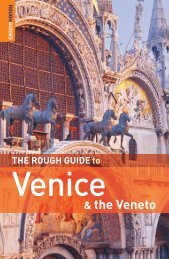You also want an ePaper? Increase the reach of your titles
YUMPU automatically turns print PDFs into web optimized ePapers that Google loves.
30<br />
whAt to see<br />
Dubrovnik justifiably invites hyperbole - every corner in<br />
<strong>the</strong> Old Town, in its entirey a UNESCO World Heritage site,<br />
has spellbinding charm and tells many a story. Although<br />
<strong>the</strong> city dates back to <strong>the</strong> 7th century, many buildings<br />
were devastated in a terrible earthquake in 1667, and<br />
were rebuilt resulting in <strong>the</strong> ra<strong>the</strong>r harmonious style you<br />
see today. The architects <strong>of</strong> Dubrovnik included <strong>the</strong> best<br />
<strong>of</strong> <strong>the</strong> Croatian masters, including Juraj Dalmatinac (also<br />
responsible for <strong>the</strong> ca<strong>the</strong>dral at Šibenik and <strong>the</strong> entire<br />
town <strong>of</strong> Pag) in combination with masters from Venice,<br />
Dubrovnik’s main rival and trading partner. Architectural<br />
beauty is perhaps a cause <strong>of</strong> a deep immersion in <strong>the</strong> arts<br />
that manifests itself in galleries and festivals.<br />
Essential Dubrovnik<br />
Dominican Monastery (Dominikanski samostan)<br />
D-2, Sv. Dominika 4, tel. (+385-20) 32 22 00. The<br />
Dominican order was established in Dubrovnik in <strong>the</strong> 13th<br />
century, and with <strong>the</strong> building <strong>of</strong> <strong>the</strong>ir monastery a century<br />
later, <strong>the</strong>y became an important part <strong>of</strong> <strong>the</strong> city’s defences<br />
- <strong>the</strong> monastery is at a strategic corner <strong>of</strong> <strong>the</strong> Old Town,<br />
vulnerable to attack from land and sea. Graceful stone<br />
steps lead up to <strong>the</strong> complex - notice that <strong>the</strong> balustrades<br />
have been filled in to prevent rogues from looking up devout<br />
ladies’ skirts! As befits <strong>the</strong> monastery’s strategic position,<br />
from <strong>the</strong> outside it is fairly austere, but inside hides a jewel<br />
<strong>of</strong> a gothic and renaissance cloister (1456-1469), with a thick<br />
carpet <strong>of</strong> grass in <strong>the</strong> centre. The interior <strong>of</strong> <strong>the</strong> monastery<br />
church is delightfully simple, with a sweeping wooden ro<strong>of</strong><br />
and some fine stone furniture. The Dominican monastery,<br />
like <strong>the</strong> Franciscan, holds an important library and collection<br />
<strong>of</strong> art including a painting <strong>of</strong> Dubrovnik before <strong>the</strong> great<br />
earthquake by local master Nikola Božidarević that has been<br />
invaluable to historians in reconstructing <strong>the</strong> look <strong>of</strong> <strong>the</strong> Old<br />
Town, as well as important works by Titian, Paolo Veneziano<br />
and Vlaho Bukovac <strong>of</strong> neighbouring Cavtat. Mass: 07:00 and<br />
19:00, Sun 08:30, 11:00 and 18:00. Q November - March 31<br />
Open 09:00 - 17:00. April - October 31 Open 09:00 - 18:00.<br />
Admission 20kn.<br />
Stradun, Placa B/C-2, . When talking about finding<br />
your way around town, you’ll <strong>of</strong>ten hear people referring to<br />
Stradun, which you won’t see on any street signs. It’s <strong>the</strong><br />
Phil Newman<br />
un<strong>of</strong>ficial name for <strong>the</strong> main street Placa that joins <strong>the</strong> two<br />
main entrances to <strong>the</strong> Old Town at Ploče in <strong>the</strong> east and<br />
Pile in <strong>the</strong> west. The name comes from <strong>the</strong> Italian strada,<br />
meaning street. With its shining limestone flags and <strong>the</strong><br />
uniform baroque buildings that line it, it is itself one <strong>of</strong> <strong>the</strong><br />
best known sights <strong>of</strong> Dubrovnik. It’s <strong>the</strong> place people bump<br />
into and chat with friends on <strong>the</strong>ir daily business, and dress<br />
up for a stroll in <strong>the</strong> evening or at c<strong>of</strong>fee time. Stradun marks<br />
<strong>the</strong> dividing line between <strong>the</strong> earliest settlement and <strong>the</strong> parts<br />
<strong>of</strong> <strong>the</strong> city that followed. This first settlement was on <strong>the</strong> land<br />
south <strong>of</strong> Stradun, and was <strong>the</strong>n named Laus, Greek for rock,<br />
since it was originally an island. From <strong>the</strong> name Laus came<br />
Raus, Rausa and <strong>the</strong>n Ragusa. Although Laus has probably<br />
been inhabited by Illyrian peoples since <strong>the</strong> 4th century, it<br />
was colonised in <strong>the</strong> 7th century by Greco-Roman refugees<br />
from Cavtat fleeing Slav incursions. Later, Slavs settled <strong>the</strong><br />
land across <strong>the</strong> narrow, marshy channel - this settlement<br />
was called Dubrava, from <strong>the</strong> Slav word for “oak tree”. The<br />
channel was filled in during <strong>the</strong> 12th century, thus creating<br />
Stradun, and <strong>the</strong> two towns integrated and began to build<br />
<strong>the</strong> city walls.<br />
The Church <strong>of</strong> St Blaise (Crkva sv. Vlaha) D-3,<br />
Luža 3. Named after <strong>the</strong> saint protector <strong>of</strong> Dubrovnik, this is<br />
perhaps <strong>the</strong> church most beloved <strong>of</strong> <strong>the</strong> city’s people. Sitting<br />
four square on Stradun, its stained glass windows by local<br />
artist Ivo Dulčić (1971) lit up at night make a wonderful show.<br />
A church has stood on this spot since 1368, but following a<br />
fire, <strong>the</strong> present church (1717) was built in Baroque style by<br />
Venetian architect Marino Gropelli, who was also sculptor<br />
<strong>of</strong> <strong>the</strong> statue <strong>of</strong> St Blaise standing above <strong>the</strong> entrance to<br />
<strong>the</strong> church, protectively holding a scale model <strong>of</strong> <strong>the</strong> Old<br />
Town in his hand. The church’s front steps are <strong>the</strong> setting<br />
for some <strong>of</strong> <strong>the</strong> most important events <strong>of</strong> <strong>the</strong> life <strong>of</strong> <strong>the</strong><br />
city, including New Year’s Eve and <strong>the</strong> opening night <strong>of</strong> <strong>the</strong><br />
Dubrovnik Summer Festival, which always used to include a<br />
concert by legendary renaissance-pop group and Eurovision<br />
contestants The Troubadours. Mass in foreign languages<br />
can be arranged by appointment. Q Open 08:00 - 12:00,<br />
16:00 - 18:00. No admission.<br />
Dubrovnik In Your Pocket <strong>dubrovnik</strong>.inyourpocket.com







